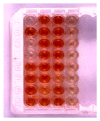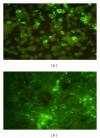Laboratory diagnosis of human rabies: recent advances
- PMID: 24348170
- PMCID: PMC3848253
- DOI: 10.1155/2013/569712
Laboratory diagnosis of human rabies: recent advances
Abstract
Rabies, an acute progressive, fatal encephalomyelitis, transmitted most commonly through the bite of a rabid animal, is responsible for an estimated 61,000 human deaths worldwide. The true disease burden and public health impact due to rabies remain underestimated due to lack of sensitive laboratory diagnostic methods. Rapid diagnosis of rabies can help initiate prompt infection control and public health measures, obviate the need for unnecessary treatment/medical tests, and assist in timely administration of pre- or postexposure prophylactic vaccination to family members and medical staff. Antemortem diagnosis of human rabies provides an impetus for clinicians to attempt experimental therapeutic approaches in some patients, especially after the reported survival of a few cases of human rabies. Traditional methods for antemortem and postmortem rabies diagnosis have several limitations. Recent advances in technology have led to the improvement or development of several diagnostic assays which include methods for rabies viral antigen and antibody detection and assays for viral nucleic acid detection and identification of specific biomarkers. These assays which complement traditional methods have the potential to revolutionize rabies diagnosis in future.
Figures




Similar articles
-
Utility of real-time Taqman PCR for antemortem and postmortem diagnosis of human rabies.J Med Virol. 2014 Oct;86(10):1804-12. doi: 10.1002/jmv.23814. Epub 2013 Oct 17. J Med Virol. 2014. PMID: 24136727
-
[A human rabies case with antemortem diagnosis].Mikrobiyol Bul. 2010 Apr;44(2):303-9. Mikrobiyol Bul. 2010. PMID: 20549967 Turkish.
-
Epidemiology of human rabies in the United States, 1980 to 1996.Ann Intern Med. 1998 Jun 1;128(11):922-30. doi: 10.7326/0003-4819-128-11-199806010-00012. Ann Intern Med. 1998. PMID: 9634432 Review.
-
Human rabies in India: an audit from a rabies diagnostic laboratory.Trop Med Int Health. 2016 Apr;21(4):556-63. doi: 10.1111/tmi.12669. Epub 2016 Feb 9. Trop Med Int Health. 2016. PMID: 26799375
-
Clinical laboratory advances in the detection of rabies virus.Clin Chim Acta. 2005 Jan;351(1-2):49-63. doi: 10.1016/j.cccn.2004.09.018. Clin Chim Acta. 2005. PMID: 15563871 Review.
Cited by
-
A Pan-Lyssavirus Taqman Real-Time RT-PCR Assay for the Detection of Highly Variable Rabies virus and Other Lyssaviruses.PLoS Negl Trop Dis. 2017 Jan 12;11(1):e0005258. doi: 10.1371/journal.pntd.0005258. eCollection 2017 Jan. PLoS Negl Trop Dis. 2017. PMID: 28081126 Free PMC article.
-
Molecular and Immunological Diagnostic Techniques of Medical Viruses.Int J Microbiol. 2020 Sep 4;2020:8832728. doi: 10.1155/2020/8832728. eCollection 2020. Int J Microbiol. 2020. PMID: 32908530 Free PMC article. Review.
-
Co-culture: A quick approach for isolation of street rabies virus in murine neuroblastoma cells.Vet World. 2015 May;8(5):636-9. doi: 10.14202/vetworld.2015.636-639. Epub 2015 May 21. Vet World. 2015. PMID: 27047148 Free PMC article.
-
Perspectives in Diagnosis and Treatment of Rabies Viral Encephalitis: Insights from Pathogenesis.Neurotherapeutics. 2016 Jul;13(3):477-92. doi: 10.1007/s13311-016-0452-4. Neurotherapeutics. 2016. PMID: 27324391 Free PMC article. Review.
-
Knowledge, attitudes, practices (KAP) and control of rabies among community households and health practitioners at the human-wildlife interface in Limpopo National Park, Massingir District, Mozambique.PLoS Negl Trop Dis. 2022 Mar 7;16(3):e0010202. doi: 10.1371/journal.pntd.0010202. eCollection 2022 Mar. PLoS Negl Trop Dis. 2022. PMID: 35255083 Free PMC article.
References
-
- World Health Organization. WHO Expert Consultation on Rabies. Second report. World Health Organization Technical Report Series. 2013;(982) - PubMed
-
- Malerczyk C, DeTora L, Gniel D. Imported human rabies cases in Europe, the United States, and Japan, 1990 to 2010. Journal of Travel Medicine. 2011;18(6):402–407. - PubMed
Publication types
MeSH terms
LinkOut - more resources
Full Text Sources
Other Literature Sources
Medical

